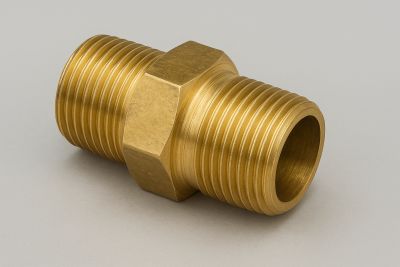Hydraulic systems play a crucial role in powering heavy machinery, industrial equipment, and fluid transmission systems across countless industries. These systems rely on precision, strength, and reliability, especially when it comes to fittings that ensure leak-free connections under high pressure. Among these essential components, the hydraulic threaded brass nipple stands out for its durability, corrosion resistance, and excellent sealing performance.
This article explores what a hydraulic threaded brass nipple is, its features, applications, and why it remains a trusted choice for high-pressure environments.
What Is a Hydraulic Threaded Brass Nipple?
A hydraulic threaded brass nipple is a short piece of pipe with male threads on both ends, designed to connect two female-threaded fittings or components in a hydraulic system. Its primary function is to extend or join fluid lines securely, ensuring consistent pressure and flow.
These nipples are typically made from brass alloys, which combine copper and zinc. This composition offers an ideal balance between strength, corrosion resistance, and machinability, making brass a preferred choice for hydraulic fittings exposed to moisture, oil, and other challenging fluids.
Threading Standards
Hydraulic threaded nipples are manufactured to meet various international standards, including:
➡️ BSP (British Standard Pipe)
➡️ NPT (National Pipe Thread)
The choice of thread type depends on system compatibility and regional specifications.
Hydraulic vs. General Plumbing Nipples
While general plumbing nipples are used for water and air systems, hydraulic nipples are engineered for high-pressure applications, featuring tighter tolerances, stronger materials, and enhanced sealing capabilities.
Key Features and Technical Specifications
Here are the key features and technical specification of hydraulic threaded brass nipple:
1. Material Properties:
Brass offers exceptional corrosion resistance, ensuring long-term durability even in harsh environments. It is also easily machinable, allowing for precision threading and smooth surface finishes.
2. Pressure Handling:
Designed for high-pressure hydraulic systems, these fittings can withstand pressures ranging from 1,000 to over 5,000 psi, depending on size and application.
3. Temperature Tolerance:
Brass maintains structural integrity in both extreme cold and high-temperature conditions, making it suitable for diverse operational environments.
4. Thread Types and Sizes:
Available in a wide range of thread standards and diameters, ensuring compatibility with various hydraulic components.
5. Leak-Proof Design:
Precision-cut threads and smooth surfaces promote tight, leak-free connections, even under pulsating or fluctuating pressures.
Benefits of Using Brass in Hydraulic Systems
Here are the advantages of using brass material in hydraulic system:
➡️ Superior Corrosion Resistance:
Unlike steel, brass resists rust and oxidation, even when exposed to water, oil, or salt air.
➡️ Extended Service Life:
Brass fittings experience less wear over time, reducing maintenance frequency and replacement costs.
➡️ Machining Precision:
Brass allows for high-accuracy threading, ensuring consistent and reliable sealing.
➡️ Fluid Compatibility:
It is compatible with a wide range of hydraulic fluids, including oils, coolants, and synthetic blends.
Applications of Hydraulic Threaded Brass Nipples
Hydraulic threaded brass nipples are used across numerous industries due to their strength, reliability, and resistance to corrosion:
1. Industrial Hydraulic Systems: Heavy machinery, hydraulic presses, and production tools.
2. Automotive and Transport: Fuel, brake, and oil line connections.
3. Construction Equipment: Excavators, loaders, cranes, and lifts.
4. Marine and Offshore Systems: Ideal for environments exposed to moisture and saltwater.
5. Agricultural and Irrigation Systems: Performs reliably in outdoor and humid conditions.
Installation and Maintenance Tips
To ensure optimal performance and safety:
➡️ Select the Correct Size and Thread Type:
Match thread standards (BSP, NPT, etc.) to avoid mismatched connections.
➡️ Proper Installation:
Use appropriate wrenches to prevent thread damage or over-tightening.
➡️ Use Reliable Sealing Materials:
Apply PTFE (Teflon) tape or thread sealant to enhance leak prevention.
➡️ Routine Maintenance:
Inspect fittings periodically for signs of wear, corrosion, or leaks, and replace if necessary.
Comparison with Other Fitting Materials
|
Material |
Corrosion Resistance |
Cost |
Strength |
Pressure Capacity |
Notes |
|
Brass |
Excellent |
Moderate |
High |
High |
Balanced performance |
|
Stainless Steel |
Superior |
Higher |
Very High |
Very High |
Ideal for extreme environments |
|
Aluminum |
Moderate |
Low |
Moderate |
Medium |
Lightweight but less durable |
|
Plastic |
Limited |
Low |
Low |
Low |
Suitable for low-pressure use only |
When to choose brass:
Opt for brass fittings when you need a cost-effective solution with excellent corrosion resistance, moderate-to-high pressure capacity, and long service life.
Safety and Performance Considerations
➡️ Verify Pressure Ratings: Always confirm that the nipple’s rated pressure matches or exceeds system requirements.
➡️ Avoid Over-tightening: Excessive torque can deform threads and compromise sealing.
➡️ Prevent Cross-Threading: Align threads carefully before tightening.
➡️ Fluid Compatibility: Ensure brass does not react with specific hydraulic fluids or system materials.
How to Choose the Right Hydraulic Threaded Brass Nipple
When selecting the correct fitting, consider the following factors:
1. Size and Thread Type: Match existing hydraulic components and regional standards.
2. Pressure Rating: Confirm suitability for your system’s maximum operating pressure.
3. Application Environment: Choose brass for systems exposed to moisture or moderate chemicals.
4. Manufacturer Standards: Look for products compliant with ISO, DIN, or SAE standards.
5. Supplier Reputation: Purchase from certified suppliers like Sannke offering material traceability and quality documentation.
Conclusion
The hydraulic threaded brass nipple is a small yet vital component that ensures the integrity and efficiency of high-pressure hydraulic systems. Its combination of durability, corrosion resistance, and precise threading makes it a preferred choice across industries — from manufacturing to marine applications.
For dependable performance, always select certified, precision-engineered hydraulic threaded brass nipples that meet international quality standards. Doing so ensures long-lasting reliability, safety, and cost-effectiveness in your hydraulic operations.
Post time: Oct-10-2025


